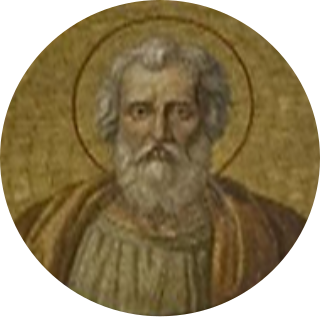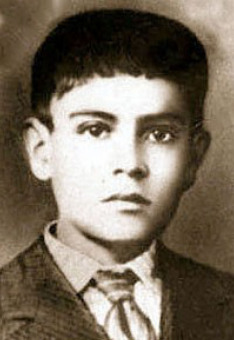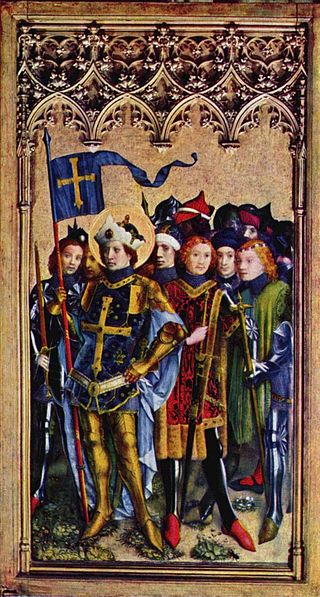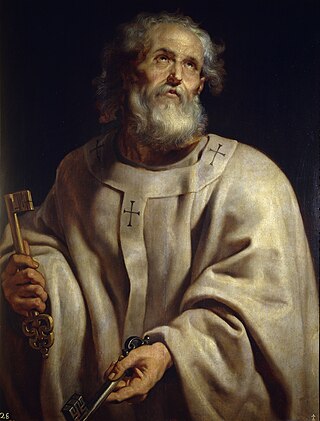Saint Mucian (Mutien, Muziano, Mucianus) is a martyr of the early Christian Church. He was killed with a sword with two other men, named Mark and Paul, as well as a little boy whose name is unknown.
The Roman Martyrology states: "The holy martyrs Mark and Mucian who were slain with the sword for Christ's sake. When a little boy called upon them with a loud voice that they should not sacrifice to idols, he was ordered to be whipped, and as he then confessed Christ more loudly, he was slain, too, together with one Paul who was exhorting the martyrs."
His feast day is July 3. Mutien-Marie Wiaux (Mucian of Malonne) took his name from this martyr.

Antipope Felix II, an archdeacon of Rome, was installed as Pope in 355 after the Emperor Constantius II banished the reigning Pope, Liberius, for refusing to subscribe to a sentence of condemnation against Saint Athanasius.

Pope Felix I was the bishop of Rome from 5 January 269 to his death on 30 December 274. Born in Rome, he succeeded Pope Dionysius and is noted for his theological contributions, particularly a significant dogmatic letter addressing the unity of Christ’s person. During his papacy, Felix I confronted the heresy of Paul of Samosata, who denied the divinity of Christ. The intervention of Emperor Aurelian, prompted by Felix, led to Paul’s deposition from the bishopric of Antioch, reinforcing orthodox Christological doctrine.

Saint Christopher is venerated by several Christian denominations. According to these traditions, he was a martyr killed in the reign of the 3rd-century Roman emperor Decius, or alternatively under the emperor Maximinus Daia. Churches and monasteries were named after him by the 7th century. There is no evidence for the historicity of the saint.

José Luis Sánchez del Río was a Mexican Cristero who was put to death by government officials because he refused to renounce his Catholic faith. His death was seen as a largely political venture on the part of government officials in their attempt to stamp out dissent and crush religious freedom in the area. He was dubbed "Joselito."

The Theban Legion figures in Christian hagiography as a Roman legion from Egypt —"six thousand six hundred and sixty-six men" — consisting of Christian soldiers who were martyred together in 286, according to the hagiographies of Maurice, the chief among the Legion's saints. Their feast day is held on September 22.

June 28 - Eastern Orthodox Church calendar - June 30

July 2 - Eastern Orthodox Church calendar - July 4

August 11 - Eastern Orthodox liturgical calendar - August 13

October 17 - Eastern Orthodox liturgical calendar - October 19
Saint Kyriaki, also known as Saint Kyriaki the Great Martyr, is a Christian saint, who was martyred under the emperor Diocletian.

January 13 - Eastern Orthodox liturgical calendar - January 15

Stanley Francis Rother was an American Catholic priest from Oklahoma who was murdered in Guatemala in 1981. He had worked as a missionary priest there since 1968. He held several parish assignments as a priest of the Archdiocese of Oklahoma City from 1963 to 1968 before being assigned to Guatemala.
Paul and Juliana were brother and sister who suffered martyrdom, at the hands of Aurelian, in 270.
Mysterii Paschalis is an apostolic letter issued motu proprio by Pope Paul VI on 14 February 1969. It reorganized the liturgical year of the Roman Rite and revised the liturgical celebrations of Jesus Christ and the saints in the General Roman Calendar. It promulgated the General Roman Calendar of 1969.

Saint Peter, also known as Peter the Apostle, Simon Peter, Simeon, Simon, or Cephas, was one of the Twelve Apostles of Jesus Christ and one of the first leaders of the early Christian Church. He appears repeatedly and prominently in all four New Testament gospels as well as the Acts of the Apostles. Catholic tradition treats Peter as the first bishop of Rome—or pope—and also as the first bishop of Antioch.

December 28 - Eastern Orthodox liturgical calendar - December 30

The Martyrs of Otranto, also known as Saints Antonio Primaldo and his Companions, were 813 inhabitants of Otranto, Salento, Apulia, in southern Italy, who were killed on 14 August 1480 after the city had fallen to an Ottoman force under Gedik Ahmed Pasha. According to a traditional account, the killings took place after the citizens had refused to convert to Islam.
The 19 martyrs of Algeria were a group of nineteen individuals slain in Algeria between 1994 and 1996 during the Algerian Civil War. They all were priests or professed religious belonging to religious congregations, including seven Trappist Cistercian monks; one was a bishop. Their nations of origin were France (15), French protectorate of Tunisia (1), Spain (2), and Belgium (1).
In 1544, during the Crisis of the Sixteenth Century (1521–1597) in the Jaffna Kingdom, Cankili I killed 600 Catholic converts. Portuguese missionaries attributed the baptism, martyrdom and intercession of the Mannar Martyrs for the rapid conversion and growth of Catholicism in Sri Lanka. In a letter found in the Archives of the Society of Jesus (S.J.) dated 19 December 1561, Anrique Anriquez the first Mannar parish priest (1561–1564) gives details to how rapidly the island was converted, and churches and hospital built all around the island. The Christians of the island of Mannar were held up as a model. He wrote since their arrival, over a thousand people converted to Christianity. A Sri Lankan trilingual film named Praana, was made in 2022, based on this incident.

Frederick Bachstein and his thirteen companions were a collective group of members, both priests and lay brothers, of the Order of Friars Minor, who were murdered by a group of Protestants in the early 17th century.